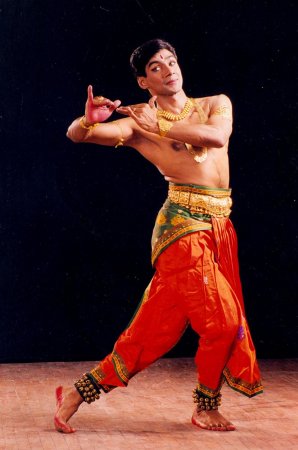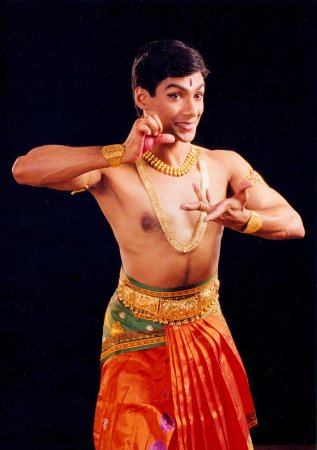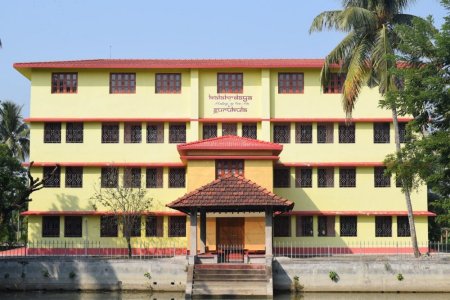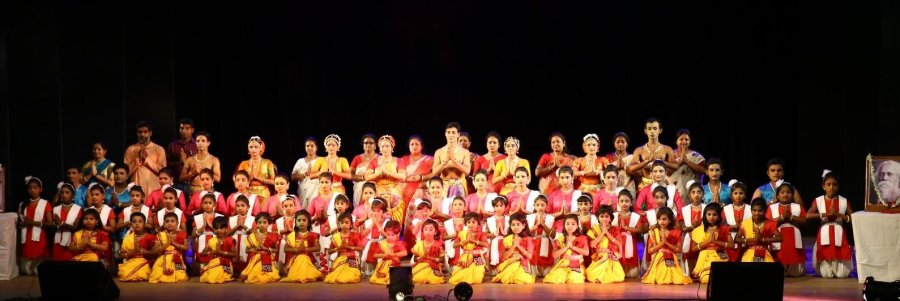 |
  |
 |
  |
Father Saju George's Kalahrdaya - Tapati Chowdhurie e-mail: tapatichow@yahoo.co.in June 21, 2024 The headlines in The Telegraph newspaper about Father Saju George (SJ) was 'DANCE, BROTHER SAJU GEORGE, DANCE.' Father George is a phenomenon - a self-made man who is both passionate about dance and about joining the Jesuit order. In his Ted Talks he said that he was excited to speak about his dance which is a vocation within a vocation. Life is worth living, he said, if you have a goal. In his teens he happened to read the book titled 'Life is Worth Living' by American author, bishop Fulton John Sheen and it gripped him. It helped him to be focused and make his life worth living for himself and the world. Born into a Syrian Catholic family in a small village called Santhipuram in Kottayam District in Kerala, to a family of 10 children, he was interested in Indian classical dance from childhood. He could sit and admire performances for hours. He had no opportunity then to learn Indian classical arts. He imitated the children of his school who could dance, which included his elder sister Seline Charles. Watching them, he picked up a few dance movements and abhinaya to evoke the navarasas and the hastamudras. He also watched some of the classical films on Indian classical music and dance like the Sagara Sangamam /Salangai Oli, Jhanak Jhanak Payal Baaje, Swarnakamalam, Ananda Bhairavi, Sankarabharanam, Vanaprastham, Kalpana, Manichitrathazhu, Dance like a Man and so on. A Catholic boy getting into serious Indian classical dance was unheard of. He had a fair share of teasing, bullying, exclusion and alienation by his peers, but he continued participating in different artistic pursuits in his school and college, winning several prizes which enthused him to go deeper into the arts. His passion for dance had to take a different route.  Father Saju George Besides dance, becoming a Jesuit was a passion too. The documentary film on the life and works of St. Peter Damian, the leper saint, at age 13 inspired him. At 17 he had read the life of Nobel Laureate Rev. Dr. Albert Schweitzer, a medical doctor, a musicologist and a Lutheran pastor titled 'Peaks of Excellence'. This made him choose his vocation to become a missionary priest. At 18, he had seen a documentary of Mother Teresa of Kolkata which made him choose Kolkata as his karmabhumi. Acting in 'Dak Ghar' or 'Post Office' by Tagore in class XI was unforgettable as was his visit to Vivekananda Rock in Kanyakumari. He admired Rabindranath Tagore and Swami Vivekananda. At 19, he left home for Kolkata to join the Jesuits. In his Novitiate library at Dhyan Ashram, he found the book 'The Intellectual Life - its Spirit, Conditions, Methods' by Fr. Antonin Sertillanges OP (Order of Preachers / Dominicans). To his great joy, Calcutta Jesuits sent him to learn Kuchipudi under Kalapeetham guru Derric Munro in Kolkata; and then to guru Vempati Chinna Satyam in Chennai where he also learnt the Kalakshetra style of Bharatanatyam under guru K. Rajkumar and qualified for a two year Certificate in Bharatanatyam. He got awards like Arul Isai Mani and Arul Isai Tilakam in Carnatic Music, a Masters in Dance from RBU, Kolkata and a PhD in the philosophy and religion of Indian classical dance from the University of Madras under the guidance of Prof. Dr. Anand Amaladoss SJ in the year 2005. From 2006, he served as the PhD Supervisor in dance at the Kalai Kaviri College of Fine Arts in Trichy under Bharatidasan University. He learnt a bit of Kathakali, Koodiyattam, Kathak, Manipuri, Ballet, Modern dance/Creative dance, Carnatic music, mridangam, chenda, Yoga, Kalaripayattu, Karate, Theater, Painting and Creative Writing as well. His D-day was when in 1996 he had his Bharatanatyam Arangetram in Kolkata. Rabindra Sadan was houseful with aficionados. Present was also his mother and his siblings. The following day, among several other newspapers, the daily Telegraph carried a critical review of his Arangetram titled "Dance, Brother (Saju) George, Dance." It was indeed the turning point in his life. An article had also appeared in the Jesuit Annual Journal 'A Jesuit professional dancer is born.' After this, there was no looking back for him. He learnt under several gurus like Leela Samson, Prof. C. V. Chandrasekhar, Kalanidhi Narayanan and her disciple Priyadarsini Govind. He studied in Rabindra Bharati University - Jora Sanko - Kolkata, when Dr. Sunil Kothari was its Uday Shankar Professor.  Father Saju George Jesuit priest and a medical doctor specialized in surgery to dedicate his life like St. Peter Damian was his ambition, but he was asked to choose one. He decided to be a Jesuit and an Indian classical dancer for their philosophy and their eternal value. Like Gurudev Tagore, he wanted to set up something like his Santiniketan. Rukmini Devi Arundale set up Kalakshetra College of Fine Arts in Chennai, Mahakavi Vallathol Narayana Menon began his Kerala Kalamandalam, and Rev. Fr. S.M. George set up Kalai Kaviri College of Fine Arts in Trichy. Why not he make a world-class centre for the arts? In 2001, Father George founded Kalahrdaya (the Heart of Art), which is now situated in Bakeswar village near Kolkata where hundreds of underprivileged children and youth may be trained in the arts. Dance took him far and wide. He has performed more than 2000 times in 35 countries. In Germany alone he has performed more than 500 times. "I keep fighting against my own inabilities, my inhibitions, my laziness, my ignorance, and my limitations." There were several experiences that could have crushed him. In 1989, he happened to share stage in Kolkata for a Youth Festival with the Indian pop singer Usha Uthup. After the first item the crowed started shouting "Nataraj...ghar jao...Nataraj... ghar jao" (Go home). Popular singer Usha Uttup had arrived and he had to stop. His dance journey was never smooth. Hurdles were endless. Afflicted with a rare bone disease for almost five years, was debilitating. Running from pillar to post from one doctor to another had greatly disillusioned him. Agonized, he called his sister-in-law, a doctor in a multi-special hospital in Kerala. There he was suggested a hip implant. "Will I ever dance again? Is there no end to suffering? I ran into the hospital chapel, fell on my knees, rolled my rosary in inconsolable tears, cried aloud for help…prayed to Our lady of Velankanni - the Mother of Good Health - for consolation. I had to face it all alone. The spiritual book I had read long back titled 'Alone with the Alone' flashed across my mind." Gathering all his courage he went back to the doctor, who told him not to worry, he would be able to dance. He advised the disconsolate soul to go back to his work and return when he was almost incapacitated. After a three year gap, Father returned to the doctor for a new hip implant. It took him a year to get back to the dance floors and to his hard work of making his Kalahrdaya - the Heart of Art; the Universal Home of Art and Culture. When he left the hospital on a wheelchair, the words kept resounding, "Dance, Father George, Dance." "My soul danced. My joy knew no bounds. Suddenly the various Biblical themes I had choreographed - Jesus healing the paralytic; giving sight to the born-blind Bartimaeus; liberating the Samaritan woman at the well; Mary Magdalene and above all the crucifixion of Jesus - seemed to come alive in my own life, in my own body and soul. And once again the Siva-tandavas, the Varnams, the Ashtapadis and so on flashed before my mind. I was full of energy and equipped suitably to go on," he said. "I let suffering humanity know that hurdles are not everlasting blocks, they are tunnels of trials and tribulations which leads to everlasting hope. God's love for us is boundless and his compassion is immeasurable. " After his surgery he has, till date, performed over 60 solos and several group performances. His body has outlived 7 surgeries, minor and major. An acute TB pleurisy that completely destroyed his lungs that took over three years to recover was another major hurdle he faced. Struck with malaria several times - a malignant one too - and two snake bites had to be suffered. Each time he seemed to go through a psycho-spiritual healing. During these agonizing times he wrote poems to save himself from total destruction. Kalahrdaya teaches, "Satyam vada, Dharmam chara...", that is, speak the truth and pursue righteousness, and never be idle. To this, Father George added the Jesuit ideal 'all for the greater glory of God'. Father Saju George is a living miracle in the field of Indian classical dance. He celebrates his dance and service to humanity with his Jesuit priesthood.  Kalahrdaya Gurukula Kalahrdaya or The Universal Home of Art and Culture is in Bakeswar, Nepalganj, Kolkata. Kalahrdaya is dedicated to promote, propagate, popularize, preserve and perpetuate the life promoting and life enhancing arts like Indian classical dances, creative and modern dances, Rabindrik / Tagore style of dance, folk, tribal and semi-classical dances; theater, vocal and instrumental music, besides other subjects, to bring the arts to the reach of the less privileged and backward communities; to utilize the arts and cultures for human and social development and to uplift the society through research oriented performances and programs. Kalahrdaya has plans to offer Graduate, Post-Graduate and Doctoral Level courses in the fields of Performing Arts besides other areas of interest. One Year Diploma Course in Dance is now being offered through St. Xavier's Autonomous College, Kolkata. The mission of Kalahrdaya is to mould "sahrdaya" - connoisseurs. Father's PhD thesis "The Religio-Philosophical Foundations of Indian Classical Dance with Special Reference to the Saiva Tradition" focuses on the Saivasidhanta text in Tamil titled Thirumantiram by sage Thirumular that led him into the core belief of Saivism - "Anbe Sivam" - God is Love. This only deepened his understanding of Jesus as the Love Incarnate and the love he lavishes on others. Kalahrdaya is at the service of knowledge, the diakonia of culture, and calls us to a new and fruitful work of making faith culturally responsible in order to revitalize, in a critical and creative way, the old and dialectical relationship between faith and culture. Late Peter Hans Kolvenbach, the former Superior General of the Jesuits, and Father George had the opportunity to dance in a Eucharistic Celebration led by Fr. Kolvenbach in Kolkata. Furthermore, Vita Consecrata (an apostolic exhortation written by Pope John Paul II) highlighted this point: "The need to contribute to the promotion of {art and} culture and to the dialogue between culture and faith is deeply felt in the Church today. It realizes the need to become interpreters of the great narration of the God-human union in contemporary cultures. And it promotes the much needed culture of peace, harmony and human unity in the world. It is also a sure and effective way to foster inter-religious dialogue and inculturation; and a means, to quote Pope Francis, for 'building a people in peace, justice and fraternity'". Kalahrdaya promises to be a beautiful bridge to build loving relationships. It is enveloped by the spirit of the divine artist who dances and sings in every heart that searches for joy, peace and harmony in oneself and desires the same in others.  Students of Kalahrdaya On 5th May 2024, I was invited to Kalahrdaya to see a recital presented by its students in the pristine style of Kalakshetra bani of Bharatanatyam. The presentation by a set of perfectly trained dancers, consisted of Ganapathi Kauthvam in ragam Nattai and talam adi, Pushpanjali offering salutation to Lord Ganesha in ragam Gambheera Nattai and talam adi; Alarippu in Tisra Jati; Jathiswaram in ragam Vasantha and talam adi; Sabdam "Aayar seriyar" in Ragamalika and talam misra chapu; Keerthanam "Natanam aadinaar" in ragam Vasantha; "Ananda natamidum paadan" in ragam Kedaragowla and Thillana in ragam Paras. Besides these, there were choreographed pieces on Rabindra Sangeet and other lighter songs presented to break the monotony of a full-fledged classical evening. Young dance aspirants showed their budding skills in dancing in their inimitable free style on songs like "Aaji Bangladesher hridoy", "Amara chash kori aanonde", "Dui hater kale mondira je", "Phagun haawaai haawaai", "Bosanthe phul ganthlo", "Bihure logon", "Mathaaal sure baajlo" etc. Besides Bharatanatyam, the students of Kalahrdaya are equally adept at Rabindrik dance, dances on Nazrul Geeti, Folk songs like Baul, Creative and Contemporary styles on varied social and artistic themes.  Tapati Chowdhurie trained under Guru Gopinath in Madras and was briefly with International Centre for Kathakali in New Delhi. Presently, she is a freelance writer on the performing arts. Post your comments Please provide your name and email id along with your comment. All appropriate comments posted with name and email id in the blog will also be featured in the site. |